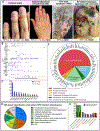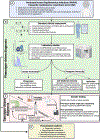Monogenic etiologies of persistent human papillomavirus infections: A comprehensive systematic review
- PMID: 37978863
- PMCID: PMC10922824
- DOI: 10.1016/j.gim.2023.101028
Monogenic etiologies of persistent human papillomavirus infections: A comprehensive systematic review
Abstract
Purpose: Persistent human papillomavirus infection (PHPVI) causes cutaneous, anogenital, and mucosal warts. Cutaneous warts include common warts, Treeman syndrome, and epidermodysplasia verruciformis, among others. Although more reports of monogenic predisposition to PHPVI have been published with the development of genomic technologies, genetic testing is rarely incorporated into clinical assessments. To encourage broader molecular testing, we compiled a list of the various monogenic etiologies of PHPVI.
Methods: We conducted a systematic literature review to determine the genetic, immunological, and clinical characteristics of patients with PHPVI.
Results: The inclusion criteria were met by 261 of 40,687 articles. In 842 patients, 83 PHPVI-associated genes were identified, including 42, 6, and 35 genes with strong, moderate, and weak evidence for causality, respectively. Autosomal recessive inheritance predominated (69%). PHPVI onset age was 10.8 ± 8.6 years, with an interquartile range of 5 to 14 years. GATA2,IL2RG,DOCK8, CXCR4, TMC6, TMC8, and CIB1 are the most frequently reported PHPVI-associated genes with strong causality. Most genes (74 out of 83) belong to a catalog of 485 inborn errors of immunity-related genes, and 40 genes (54%) are represented in the nonsyndromic and syndromic combined immunodeficiency categories.
Conclusion: PHPVI has at least 83 monogenic etiologies and a genetic diagnosis is essential for effective management.
Keywords: HPV; Inborn errors of immunity; Monogenic disorder; Persistent human papillomavirus infection; Recalcitrant wart.
Copyright © 2023 American College of Medical Genetics and Genomics. Published by Elsevier Inc. All rights reserved.
Conflict of interest statement
Conflict of Interest Jean-Laurent Casanova serves on the scientific advisory boards of ADMA Biologics Inc., Kymera Therapeutics, and Elixiron Immunotherapeutics.
Figures



References
-
- McBride AA. Human papillomaviruses: diversity, infection and host interactions. Nature Reviews Microbiology. 2022;20(2):95–108. - PubMed
-
- Leung L Recalcitrant nongenital warts. Australian family physician. 2011;40(1/2):40–2. - PubMed
-
- Sullivan KE, Stiehm ER. Stiehm's Immune Deficiencies: Inborn Errors of Immunity: Academic Press; 2020.
Publication types
MeSH terms
Substances
Grants and funding
LinkOut - more resources
Full Text Sources
Medical
Miscellaneous

